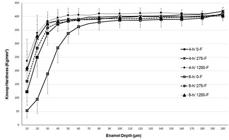Abstract
Fluoride present in toothpaste at 1,100 µg/g is considered effective on caries control. However, under high cariogenic challenge due to increasing sugar exposure, higher fluoride concentration (5,000 µg/g) could be necessary to compensate the unbalance on caries process. This was tested in a pH-cycling regimen, which evaluated the effect of fluoride concentration relative to toothpaste on reduction of enamel demineralization under conditions of two levels of cariogenic challenge. Enamel slabs (n=20) were subjected to two pH-cycling regimens, simulating 8x and 16x/day sugar exposure and were treated with solutions containing: 0 (no fluoride), 275 or 1,250 µg F/mL, resulting in 6 treatment groups: 4-h/0-F; 8-h/0-F; 4-h/275-F; 8-h/275-F; 4-h/1,250-F and 8-h/1,250-F. The 275 and 1,250 µg F/mL concentrations simulate mouth salivary dilution when 1,100 and 5,000 µg/g toothpastes are used. Enamel demineralization was assessed by surface (%SHL) and cross-sectional hardness. Fluoride taken up by enamel was also evaluated. Data were analyzed by ANOVA one-way and Tukey's test. The treatment with 1,250 µg F/mL significantly reduced %SHL compared with 275 µg F/mL (p<0.05), irrespective the level of cariogenic challenge (4-h/1,250-F vs. 4-h/275-F and 8-h/1,250-F vs 8-h/275-F comparisons, respectively). These data were supported by fluoride concentration found in enamel. These findings suggest that higher fluoride concentrations could partly compensate the greater caries risk under higher cariogenic challenge due to increasing sugar exposure.
Key Words:
dental caries; dental enamel; fluorides; tooth demineralization; toothpaste

 Thumbnail
Thumbnail


